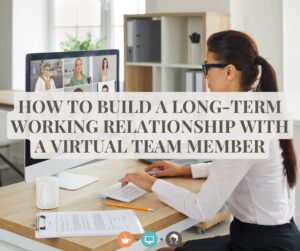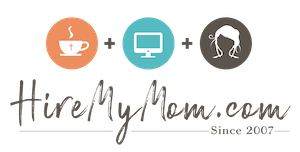How to Build a Long-Term Working Relationship with a Virtual Team Member

Whether you’re a small business owner managing remote workers or a virtual assistant eager to turn a short project into a steady client relationship, long-term collaboration takes more than good intentions. It requires structure, trust, and clear communication. Here’s how to build a relationship that lasts well beyond the first project.
1. Start with Clarity through Shared Goals and Ground Rules
The best working relationships begin with clarity. Before diving into tasks, take time to define expectations from both sides.
For business owners: Be explicit about project scope, communication preferences, and performance measures. Spell out how you’ll track progress, whether it’s weekly check-ins, milestones, or deliverables.
For freelancers: Confirm every detail before work begins. Restate goals in your own words to make sure you’re on the same page, and document agreements about hours, deadlines, and feedback channels.
A “working agreement” doesn’t need to be complicated; it’s just a mutual understanding that eliminates guesswork. Think of it as the foundation of trust.
2. Create a Communication Rhythm That Works Remotely
The biggest challenge in managing remote workers is communication drift. Without consistent touchpoints, even talented professionals can veer off course.
For business owners: Set a predictable communication rhythm. That could mean a Monday morning summary email, a biweekly project meeting, or a quick Friday check-in message. Choose tools that streamline, not complicate such as Slack or Asana for updates, Zoom or Google Meet for milestone reviews, Loom for quick walkthroughs.
For freelancers: Don’t wait for clients to reach out first. Proactive updates show accountability and build confidence. A simple “Here’s where we are this week, here’s what’s next” keeps everyone aligned.
Clarity beats frequency because short, structured updates build more trust than long, unplanned messages.
3. Give Feedback That Builds, Not Breaks
Long-term success hinges on feedback that’s specific, respectful, and timely.
For business owners: Deliver feedback often and constructively. Instead of “This isn’t right,” say, “The tone feels a little too formal, let’s make it more conversational like last week’s post.” Pair criticism with recognition. When you acknowledge what’s working, your freelancer is more motivated to fix what’s not.
For freelancers: Don’t take feedback personally, take it as direction. Ask clarifying questions (“Would you like me to focus more on design or speed next time?”) to ensure alignment. Over time, your responsiveness builds trust that turns into repeat business.
Both sides benefit from a “feedback loop”: exchange small corrections early rather than big frustrations later.
4. Boundaries Build Trust, Not Distance
A healthy working relationship respects boundaries because reliability depends on them.
For business owners: Remember that freelancers aren’t full-time employees. Avoid last-minute weekend requests unless you’ve discussed availability ahead of time. Communicate deadlines clearly and give as much notice as possible.
For freelancers: Set your working hours and stick to them. It’s better to communicate, “I’m offline after 4 PM but will handle this first thing tomorrow,” than to disappear unexpectedly. Consistency and transparency are what make clients trust your independence.
Good boundaries don’t limit flexibility, they make it sustainable.
5. Reliability Is the Real Currency of Remote Work
Skill gets you hired; reliability keeps you hired.
For business owners: Paying on time, offering consistent projects, and honoring agreed timelines show professionalism. Freelancers who feel valued will go above and beyond.
For freelancers: Reliability means meeting deadlines, communicating changes early, and delivering quality every time. A freelancer who consistently exceeds expectations becomes indispensable.
Reliability is mutual. When both sides deliver what they promise, long-term collaboration becomes effortless.
6. Appreciation and Inclusion Go a Long Way
Gratitude is one of the simplest ways to strengthen a professional relationship yet it’s often overlooked.
For business owners: A quick “thank you” or a small bonus for a job well done shows appreciation. Invite freelancers to team meetings or share wins that resulted from their contributions. Inclusion builds loyalty.
For freelancers: Express appreciation for the trust and opportunities your client provides. A message like, “I’ve really enjoyed collaborating on this campaign, it’s rewarding to see the results,” reinforces goodwill and professionalism.
Remote partnerships thrive when both sides feel seen and valued.
7. Handle Growth and Change Together
If your collaboration is going well, it will evolve. Roles expand, rates change, and new needs emerge. That’s a sign of success.
For business owners: When your freelancer consistently delivers, consider offering a retainer or expanding their responsibilities. It’s more efficient than rehiring and deepens their understanding of your business.
For freelancers: Communicate when your workload or skills evolve. Propose new ways to add value like managing a process you’ve mastered or training a new team member.
Growth should be a conversation, not a surprise. Long-term relationships thrive when both sides adapt transparently.
8. Avoid the Common Pitfalls That Break Remote Relationships
Even good collaborations can fail when basic principles are overlooked. Watch out for these avoidable pitfalls:
- Only communicating when something goes wrong.
- Failing to document processes or expectations.
- Ignoring time zone differences or overstepping work hours.
- Missing payments or not confirming receipt of invoices.
- Letting minor misunderstandings grow into frustration instead of resolving them quickly.
When issues arise, address them directly but calmly. Most remote relationship problems come from silence, not conflict.
9. Turn a Trial Project into a Partnership
Every long-term relationship starts with one project. The key is to treat that first assignment as both a test and an opportunity.
For business owners: Notice how your freelancer communicates, problem-solves, and takes initiative. A trial project lets you assess not just skill but reliability and chemistry.
For freelancers: Use the first project to learn how your client prefers feedback, what tools they use, and what matters most to them. Deliver early, communicate clearly, and exceed expectations as that’s how short-term work becomes steady income.
The best partnerships grow from small wins repeated consistently. Clarity, respect, and communication turn one-off projects into partnerships that can last for years.
When both sides invest in understanding and reliability, remote collaboration becomes one of the most rewarding parts of doing business.
Whether you’re ready to find your next great freelancer or take on a new client you’ll love working with, there’s no better time to start. Visit HireMyMom.com to post a job or find a job!



